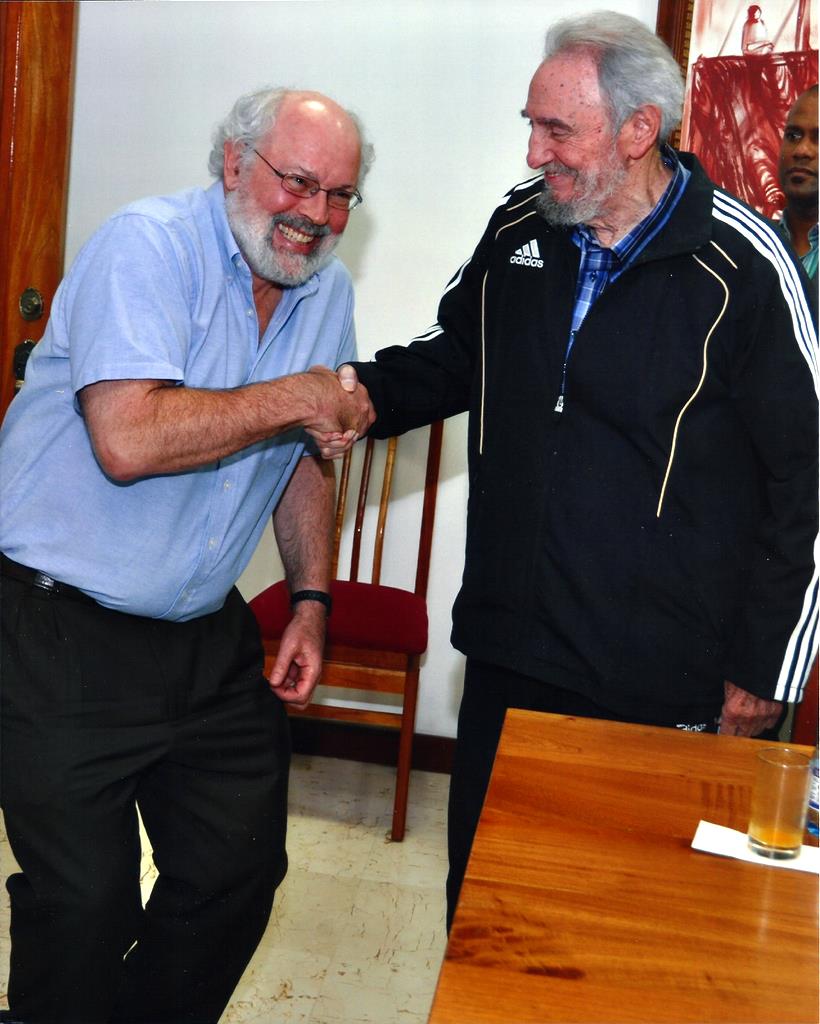 Alan Robock's trip to Cuba,
December 12-16, 2011
Alan Robock's trip to Cuba,
December 12-16, 2011  Alan Robock's trip to Cuba,
December 12-16, 2011
Alan Robock's trip to Cuba,
December 12-16, 2011
The week after the 2011 Fall AGU Meeting, when I became an AGU Fellow and wore a tuxedo for the first time, I went to Cuba as part of a AAAS delegation. We stayed at the Hotel Nacional (view from my room, Christmas tree in the lobby, celebrating 53 years of revolution), and visited the Cuban Institute of Meteorology (INSMET) - their national weather service - across the harbor from downtown Havana, where Anne Thompson gave a short talk. The group of atmospheric scientists was not large - Roger Rivero, René Estevan, and Juan Carlos Antuña from Camaguey, Tomás Gutiérrez from INSMET, Anne Thompson from Penn State, Olga Mayol-Bracero from the University of Puerto Rico, and me. We met both in the old casino of the Hotel Nacional and on the veranda. Anne, Olga, and I took a tour of the tunnels on the front lawn where the tour guide, Estela, had lived for three months in preparation to defend against an American invasion that never happened in October, 1962. Fidelito attended the opening ceremony on Tuesday and did a TV interview. On Tuesday night, the American delegation hosted a dinner at the Hotel. The next night, the Cubans hosted a dinner at the National Aquarium, which included a dolphin show. The dolphins pushed the four divers around in precise formations, but we felt sorry for them confined in such a small tank. The last day of meetings I was invited to lunch at the Cafe del Oriente, one of the nicest restaurants in Havana, by Fidelito along with Michael Clegg (US National Academy of Sciences), Sergio Pastrana (Cuban Academy of Sciences), Vaughan Turekian (AAAS, back), Peter Agre (front), Tomás Gutiérrez, and Juan Carlos Antuña. After Fidelito handed out signed copies of his new book, Nuclear Energy, I gave him two Rutgers baseball caps, one blue and one black, one for him and one for his father. He asked which was for him, and I told him to take either one and give the other to his father. He said that maybe his father should decide. I said, "What!?" He said we were going to meet with him that afternoon.
It turned out that Peter Agre and I were the only Americans invited, along with Juan Carlos and Tomás, and we spent 3 1/2 hours with Fidel. We waited for a little while, and then entered the same room where I met with Fidel last year. He greeted me, and we sat at a table with Fidel Castro Ruz, his wife Dalia Soto del Valle, his sons Fidel Castro Diaz-Balart and Antonio Castro Soto del Valle, and Peter Agre, Juan Carlos Antuña, Tomás Gutiérrez, and Betty Muñoz (interpreter) on the other. Fidel talked 99% of the time, and we talked only 1%, but it was fascinating. Fidel seemed to really enjoy the opportunity to talk about lots of things. Peter and I wrote down what we remembered from the meeting, including Fidel's views on the Bay of Pigs invasion, the Cuban Missile Crisis, Presidents Kennedy and Nixon, movies, books, and his youth, which you can read here. As we were leaving I shook hands with Fidel, and he commented that I had grown since we had met the year before. So I stooped down to be the same height, but I can think of many other captions for this picture. I gave Fidel a baseball cap and he said he would put it on before we left, but did not. However, Fidelito liked his. We left the next day, and I was surprised at how many flights there are each day between Miami and Havana.
The trip is described in detail in the AGU Atmospheric Sciences Section Newsletter Vol. 6, No. 2 (5.4 Mb). It is not illegal for Americans to travel to Cuba. You can travel legally to Cuba for research, and I encourage other scientists to engage in scientific exchange with Cuba.
Prepared by Alan Robock (robock@envsci.rutgers.edu) - Last updated on March 10, 2023
Alan Robock and Fidel Castro, December 2011 by Alan Robock is licensed under CC BY-NC-SA 4.0